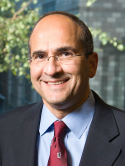Nipple-sparing mastectomy: Initial experience at the Memorial Sloan-Kettering Cancer Center and a comprehensive review of literature Journal Article
| Authors: | Garcia-Etienne, C. A.; Cody, H. S. 3rd; Disa, J. J.; Cordeiro, P.; Sacchini, V. |
| Article Title: | Nipple-sparing mastectomy: Initial experience at the Memorial Sloan-Kettering Cancer Center and a comprehensive review of literature |
| Abstract: | Success achieved with skin-sparing mastectomy has led surgeons to reconsider the necessity of nipple-areola complex removal. This study reports our short- and mid-term postoperative outcomes with nipple-sparing mastectomy (NSM) and an updated review of reported literature. Data were retrospectively abstracted from medical records at our institution. Patients underwent NSM based on patient preference, oncologic criteria, and cosmesis. A literature review was undertaken through a PUBMED search and selected based on title and abstract relevance. Twenty-five patients underwent 42 NSMs at our institution from July 2000 to October 2005. Patient mean age was 44 years (29-59 years). Indications for mastectomy were: 34 (81%) for prophylaxis, 5 (12%) for invasive ductal carcinoma, 2 (5%) for ductal carcinoma in situ, and 1 (2%) for a malignant phyllodes tumor. One prophylactic mastectomy specimen showed ductal carcinoma in situ in the retroareolar tissue, and the nipple-areola complex was removed at a second operation. Mean tumor size in cases with invasive carcinoma (n = 5) was 1.9 cm (0.7-2.5 cm). All tumors were peripherally located, and no cases showed occult nipple involvement. The nipple-areola complex was entirely preserved in 39 (93%) mastectomies. One nipple-areola complex was surgically removed, and two (5%) cases had partial loss due to infection or ischemia. Cosmetic result from surgeon's assessment was excellent in 30 mastectomies, good in 7, acceptable in 3, and poor in 2, with slight nipple asymmetry in 8 cases. At a median follow-up of 10.5 months (range, 0.4-56.4 months), the 39 nipple-areola complexes were intact and there were no local or systemic recurrences in cases treated for cancer. NSM represented approximately 1% of all mastectomies performed at our institution during the reported period. It was mostly used for prophylaxis and for the treatment of malignant tumors in few selected cases. NSM can be performed with a high success rate of nipple-areola complex preservation. Conclusions about the oncologic safety of this procedure cannot be drawn from our study due to small size series and short follow-up. However, available published data show that NSM can be safely performed for breast cancer treatment in carefully selected cases. Further studies and longer follow-up are necessary to refine selection criteria for NSM. © 2009 Wiley Periodicals, Inc. |
| Keywords: | adult; clinical article; treatment outcome; cancer surgery; surgical technique; cancer risk; patient selection; follow up; sentinel lymph node biopsy; breast cancer; cystosarcoma phylloides; mastectomy; tumor volume; retrospective study; postoperative complication; skin; cancer center; ischemia; carcinoma in situ; medical record; postoperative infection; invasive carcinoma; nipple; risk reduction; areola-sparing mastectomy; cosmetic mastectomy; nipple-areola complex; nipple-sparing; nipple-sparing mastectomy; skin-sparing mastectomy; breast areola; breast surgery; esthetic surgery; intraductal carcinoma; nipple sparing mastectomy; skin sparing mastectomy |
| Journal Title: | Breast Journal |
| Volume: | 15 |
| Issue: | 4 |
| ISSN: | 1075-122X |
| Publisher: | Wiley Blackwell |
| Date Published: | 2009-07-01 |
| Start Page: | 440 |
| End Page: | 449 |
| Language: | English |
| DOI: | 10.1111/j.1524-4741.2009.00758.x |
| PROVIDER: | scopus |
| PUBMED: | 19496781 |
| DOI/URL: | |
| Notes: | --- - "Cited By (since 1996): 3" - "Export Date: 30 November 2010" - "CODEN: BRJOF" - "Source: Scopus" |
Altmetric
Citation Impact
BMJ Impact Analytics
MSK Authors
Related MSK Work







